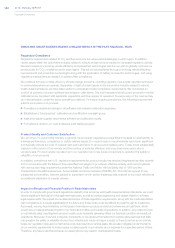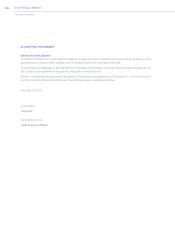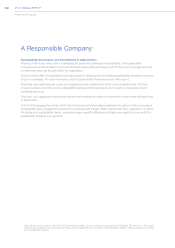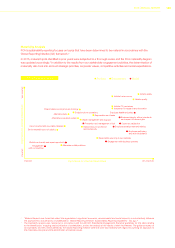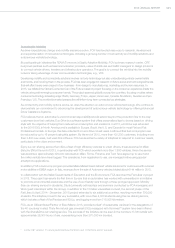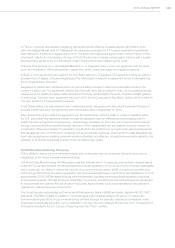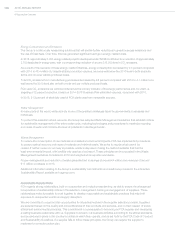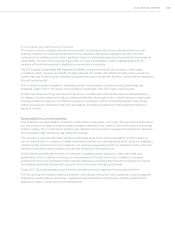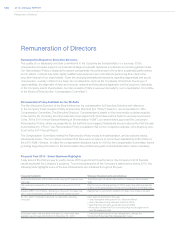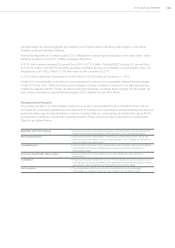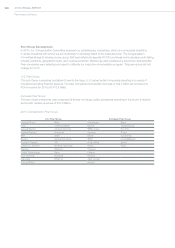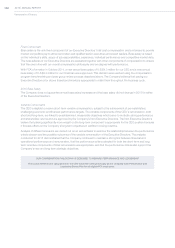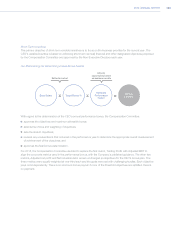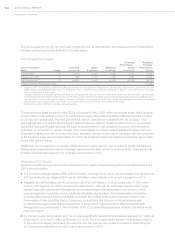Chrysler 2015 Annual Report Download - page 114
Download and view the complete annual report
Please find page 114 of the 2015 Chrysler annual report below. You can navigate through the pages in the report by either clicking on the pages listed below, or by using the keyword search tool below to find specific information within the annual report.
114 2015 | ANNUAL REPORT
A Responsible Company
Health and Safety in the Workplace
FCA strives to provide a safe and healthy working environment at every site worldwide and in every area of activity.
The Group’s health and safety approach focuses on the following key areas:
application of uniform procedures for identification and evaluation of risks
adherence to the highest safety and ergonomics standards for plant and machinery design
promotion of safe behavior through training initiatives and awareness campaigns
provision of a healthy work environment and promotion of a healthy lifestyle.
The goal of achieving “zero accidents” is formalized in the Health and Safety Guidelines - which form the basis for
policies in each area of activity - and through global adoption of an Occupational Health and Safety Management
System (OHSMS) certified to the OHSAS 18001 standard. Effective safety management is also supported by the
application of World Class Manufacturing tools and methodologies, active involvement of employees, development of
specific know-how and targeted investment.
Investment in health and safety, combined with other measures, has resulted, for example, in a progressive reduction
in the level of risk attributed to FCA plants in Italy by INAIL, the Italian accident and disability insurance agency. As a
result, the Group was eligible for “good performer” premium discounts, which enabled savings of approximately €88
million in 2011-2015. In addition to safety in the workplace, the Group has numerous initiatives to promote the health
and well-being of employees and their families.
Industrial Relations
Collective Bargaining
In 2015, collective bargaining made it possible to reach trade union agreements for the definition of salary and regulatory
conditions following procedures which vary among the various countries in accordance with local law and practices.
Worldwide, 85 percent of FCA employees are covered by collective bargaining agreements. In 2015, 252 trade union
agreements were stipulated at the company or plant level.
In Italy, all FCA employees are covered by collective bargaining.
In Italy, on July 7, 2015, the company-specific collective labor agreement (CCSL) was renewed with the Trade Unions
FIM-CISL, UILM-UIL, FISMIC, UGL Metalmeccanici e Associazione Quadri e Capi Fiat.
The main provision of the four-year agreement (2015-2018) is an innovative performance-based compensation
scheme which was first introduced at Automobiles sector (Ferrari excluded) and has been subsequently extended to
all FCA companies in Italy.
Outside Italy, approximately 79 percent of Group employees are covered by collective bargaining. This is an average
figure which covers various situations in accordance with current regulations and practices in the various countries.
Considering the economic context of the majority of the countries within the European Union, which again recorded
trends which are mostly deflationary and indicative of incomplete capacity utilization, the 2015 trade-union salary
agreements aimed, where the conditions were in place, not to increase the cost of labor at a structural level, but to
grant conditions based on specific company performance metrics.
In Poland, collective salary negotiations at the company level led to salary increases substantially aligned with inflation
within the Group companies with increasing volumes of business. In July 2015, FCA Poland and the majority of the
trade unions reached an agreement on the introduction of a new performance-based compensation scheme for the
period 2016-2018 which is similar to the model defined in Italy.


